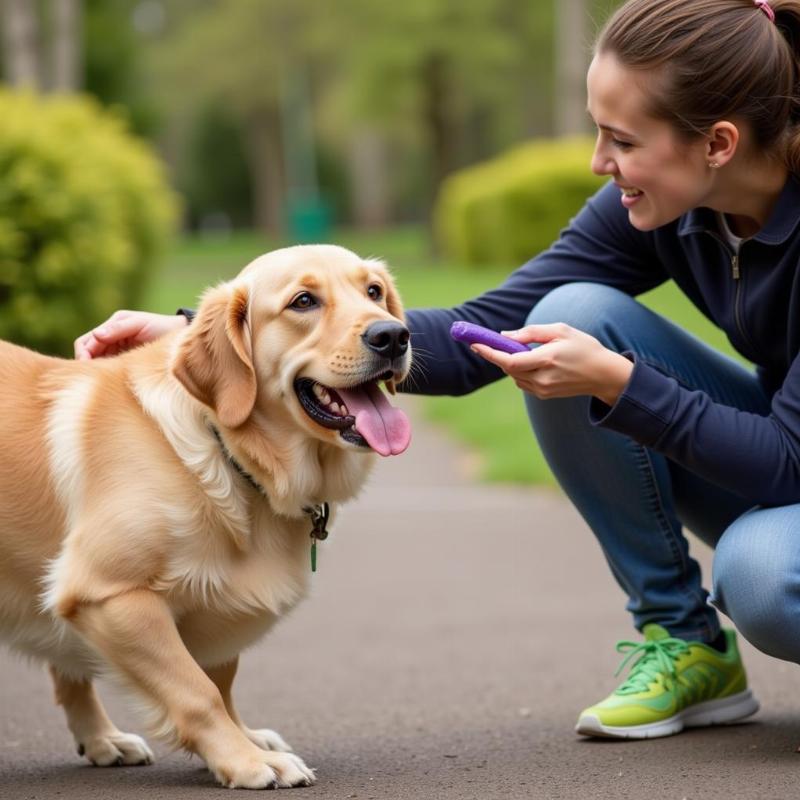Dog shock collars, especially for dogs with thick fur, can be a controversial topic. Finding the right collar that effectively penetrates a dense coat without causing harm requires careful consideration. This guide will explore the nuances of using shock collars for thick-furred dogs, addressing safety concerns, training effectiveness, and ethical implications, while offering alternatives and highlighting the importance of positive reinforcement training methods.
Understanding Shock Collars and Thick Fur
One of the main concerns with using a shock collar on a dog with thick fur is the reduced conductivity. The fur can act as insulation, lessening the impact of the shock. This can lead owners to increase the intensity, potentially causing unnecessary discomfort or even harm. Understanding how these collars work and their potential impact on your furry friend is crucial before considering their use.
Choosing the Right Shock Collar for Thick-Coated Breeds
If you’re considering a shock collar for a thick-coated breed, it’s vital to choose a model specifically designed for this purpose. Look for collars with longer prongs that can reach through the fur and make proper contact with the skin. best shock collar for large dogs with thick fur Some collars are designed with adjustable prong lengths to accommodate different fur thicknesses. Remember, the goal is not to inflict pain, but to provide a consistent and noticeable stimulation for training purposes.
Safety and Ethical Considerations
While shock collars can be effective training tools in certain situations, their use should always be approached with caution. The American Kennel Club (AKC) recommends positive reinforcement methods as the preferred training approach.  Huấn luyện chó bằng phương pháp củng cố tích cực It’s important to consider the potential psychological effects on your dog, especially breeds sensitive to harsh corrections.
Huấn luyện chó bằng phương pháp củng cố tích cực It’s important to consider the potential psychological effects on your dog, especially breeds sensitive to harsh corrections.
Alternatives to Shock Collars
Positive reinforcement training, utilizing rewards and praise, is generally a more humane and effective long-term solution. glow in dark dog leash Other alternatives include vibration collars, which offer a less intense stimulus, and ultrasonic training devices. These methods focus on building a positive relationship with your dog and encouraging desired behaviors without the use of aversive stimuli.
Training Techniques with Shock Collars
If, after careful consideration and consultation with a certified professional dog trainer, you decide to use a shock collar, it’s crucial to implement proper training techniques. best tie out for large dogs Consistency and timing are key to achieving desired results without causing undue stress to your dog.
Working with a Professional Trainer
Consulting a certified professional dog trainer is highly recommended, especially if you’re new to using training collars. They can provide personalized guidance on proper usage, help you choose the right settings, and ensure the safety and well-being of your dog. wire for invisible dog fence A trainer can also help you understand your dog’s individual needs and temperament, allowing for a more tailored training approach.
Conclusion
Choosing a dog shock collar for thick fur requires careful research, consideration, and a commitment to responsible training practices. Prioritize your dog’s well-being by exploring alternative methods and consulting with professionals. Remember, building a strong, positive relationship with your dog should always be the foundation of any training program.
FAQ
- Are shock collars cruel? The use of shock collars is a debated topic. While some find them effective, others consider them inhumane. Proper usage and training are crucial to avoid causing harm.
- What are the best shock collars for dogs with thick fur? Collars with longer, adjustable prongs are best for penetrating thick fur.
- Are there alternatives to shock collars? Yes, positive reinforcement, vibration collars, and ultrasonic devices are viable alternatives.
- Should I consult a trainer before using a shock collar? Consulting a certified professional dog trainer is highly recommended.
- Can shock collars be used on puppies? It’s generally not recommended to use shock collars on puppies.
- How do I find a qualified dog trainer? The AKC and other reputable organizations offer resources to find certified dog trainers in your area.
- What are the long-term effects of shock collar use? Improper use can lead to behavioral problems and anxiety in dogs.
Related Articles
About Beautdogs.us
Beautdogs.us is your premier online resource for all things dog-related in the United States. We offer expert advice on dog breeds, care, training, and product reviews, catering to both new and experienced dog owners. From choosing the right breed to understanding the nuances of dog behavior, Beautdogs.us is your trusted source for comprehensive and engaging information. We’re passionate about helping you build a strong and loving bond with your canine companion. Contact us for personalized support: Email: [email protected], Phone: +1 501-555-7529. Visit Beautdogs.us today!